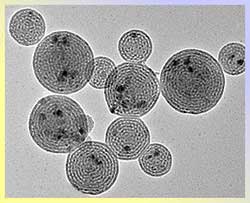| Posted: March 8, 2007 |
Multipurpose particles made easy |
|
(Nanowerk News) Researchers in France have developed a simple way to make inorganic microspheres that could be used for carrying and releasing drugs.
|
|
Clément Sanchez at the Pierre & Marie Curie University, Paris, in collaboration with Etienne Duguet at the University of Bordeaux 1 and colleagues made a composite material, consisting of magnetic iron oxide nanoparticles embedded in silica microspheres. Metal-silica composite particles have been made before, but Sanchez's team have come with what they say is a simple, cheap and versatile method that is easy to scale up ("Mesoporous maghemite–organosilica microspheres: a promising route towards multifunctional platforms for smart diagnosis and therapy").
|
 |
| Maghemite-silica composite microspheres can be made by a simple spray drying tecnique
|
|
The researchers used a spray drying technique, which is widely used in the food and pharmaceutical industries. They started with a mixture of a silica precursor, a surfactant, a catalyst and some maghemite (gamma-Fe2O3) nanoparticles in a water-ethanol solvent. This solution was pumped through an atomiser to create tiny aerosol droplets, which were then passed through a heating zone to remove the solvent. The evaporation triggered the self assembly of silica, creating the maghemite-silica composite spheres.
|
|
Iron oxide particles embedded in biocompatible polymers, such as starch or albumin, are currently used as magnetic resonance imaging (MRI), contrast agents. But the researchers say that an advantage of using silica to encapsulate magnetic particles is that the silanol groups on the silica surface could be used to attach drug molecules. The drug-carrying microspheres could then be tracked in the body using MRI, thanks to the embedded magnetic particles.
|
|
Hyperthermia, the use of heat to kill cancer cells, is another potential use of these microspheres, which heat up in a magnetic field. According to Sanchez, this property could also be used to trigger drug release.
|
|
The simple synthesis that the scientists have developed is adaptable so different amounts of magnetic iron oxide can be used. The size and chemical properties of the pores in the particles can also be adjusted for different medical uses.
|

